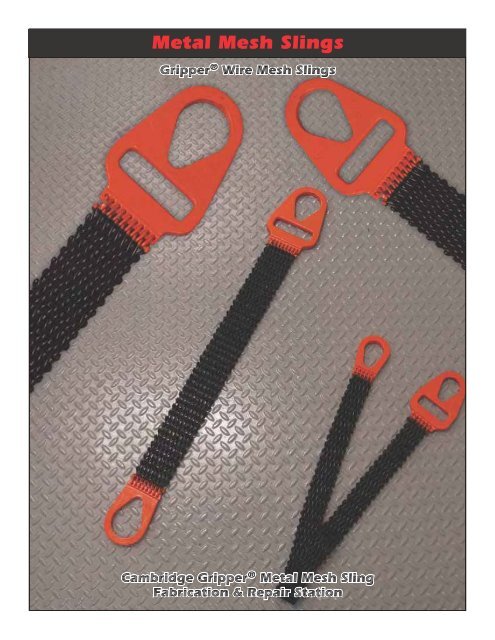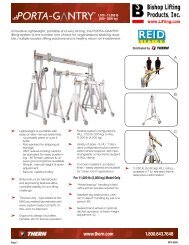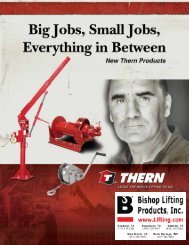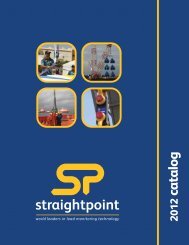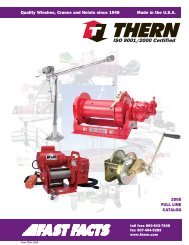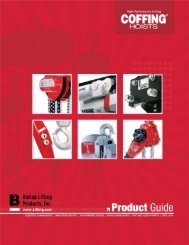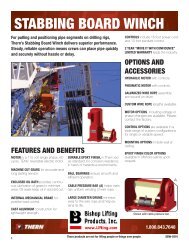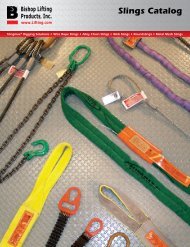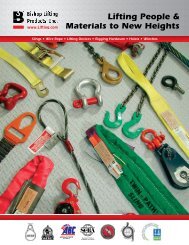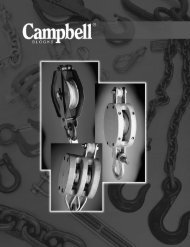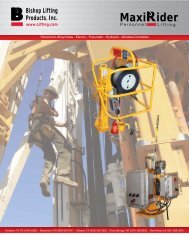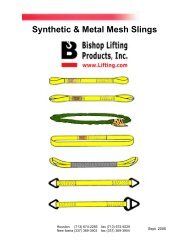Metal Mesh Slings
Metal Mesh Slings
Metal Mesh Slings
Create successful ePaper yourself
Turn your PDF publications into a flip-book with our unique Google optimized e-Paper software.
<strong>Metal</strong> <strong>Mesh</strong> <strong>Slings</strong><br />
Gripper ® Wire <strong>Mesh</strong> <strong>Slings</strong><br />
Cambridge Gripper ® <strong>Metal</strong> <strong>Mesh</strong> Sling<br />
Fabrication & Repair Station
Length<br />
(Feet - In)<br />
<strong>Metal</strong> mesh sling with choker and basket fi tting<br />
Features:<br />
G-35 heavy duty metal mesh, carbon steel, 10 gauge<br />
Tolerates temperatures up to 550° F, or even higher, when made of special alloy<br />
<br />
Proof tested to 2X rated capacity<br />
Design factor of 5 to 1<br />
How to order:<br />
Combine model and length in feet<br />
Model<br />
Type 1<br />
Part Number<br />
Length Feet<br />
Width<br />
Inches<br />
Choker<br />
Vertical<br />
Basket<br />
Rated Capacities in Lbs.<br />
Basket<br />
60° from<br />
Horizontal<br />
Basket<br />
45° from<br />
Horizontal<br />
WARNING<br />
See metal mesh slings warnings page<br />
for warnings and inspection criteria<br />
Basket<br />
30° from<br />
Horizontal<br />
1MM02X * 2 1,600 3,200 2,700 2,000 1,600<br />
1MM03X * 3 3,000 6,000 5,100 3,800 2,800<br />
1MM04X * 4 4,400 8,800 7,480 5,600 4,400<br />
1MM06X * 6 6,600 13,200 11,225 8,400 6,600<br />
1MM08X * 8 8,800 17,600 15,000 11,250 8,800<br />
1MM10X * 10 11,000 22,000 18,700 14,000 11,000<br />
1MM12X * 12 13,200 26,400 22,440 16,800 13,200<br />
1MM14X * 14 15,400 30,800 26,180 19,600 15,400<br />
1MM16X * 16 17,600 35,200 29,920 22,400 17,600<br />
1MM18X * 18 19,800 39,600 33,660 25,200 19,800<br />
1MM20X * 20 22,000 44,000 37,400 28,000 22,000<br />
Note:<br />
<br />
See dimensional data page for weights<br />
METAL MESH<br />
SLINGS<br />
<strong>Metal</strong> <strong>Mesh</strong> <strong>Slings</strong> 134<br />
(800) 972-1041
Length<br />
(Feet - In)<br />
2MM -Type 2<br />
<strong>Metal</strong> mesh sling with basket fi tting each end<br />
Features:<br />
G-35 heavy duty metal mesh, carbon steel, 10 gauge<br />
Tolerates temperatures up to 550° F, or even higher, when made of special alloy<br />
<br />
Proof tested to 2X rated capacity<br />
Design factor of 5 to 1<br />
How to order:<br />
Combine model and length in feet<br />
Model<br />
Type 2<br />
Part Number<br />
Length Feet<br />
Width Inches<br />
Vertical Basket<br />
Basket<br />
60° from<br />
Horizontal<br />
Rated Capacities in Lbs.<br />
Basket<br />
45° from<br />
Horizontal<br />
WARNING<br />
See metal mesh slings warnings page<br />
for warnings and inspection criteria<br />
Basket<br />
30° from<br />
Horizontal<br />
2MM02X * 2 3,200 2,700 2,000 1,600<br />
2MM03X * 3 6,000 5,100 3,800 2,800<br />
2MM04X * 4 8,800 7,480 5,600 4,400<br />
2MM06X * 6 13,200 11,225 8,400 6,600<br />
2MM08X * 8 17,600 15,000 11,250 8,800<br />
2MM10X * 10 22,000 18,700 14,000 11,000<br />
2MM12X * 12 26,400 22,440 16,800 13,200<br />
2MM14X * 14 30,800 26,180 19,600 15,400<br />
2MM16X * 16 35,200 29,920 22,400 17,600<br />
2MM18X * 18 39,600 33,660 25,200 19,800<br />
2MM20X * 20 44,000 37,400 28,000 22,000<br />
Note:<br />
<br />
See dimensional data page for weights<br />
METAL MESH<br />
SLINGS<br />
(800) 972-1041 <strong>Metal</strong> <strong>Mesh</strong> <strong>Slings</strong> 135
METAL MESH SLING WARNINGS<br />
When inspecting a metal mesh sling, it shall be taken out of service immediately and returned for repair or replacement when any<br />
of the below defects are present.<br />
Missing or illegible sling<br />
identification<br />
Distortion of either<br />
fitting so that the width<br />
of the eye opening is<br />
decreased more than<br />
10%<br />
Broken weld or a broken<br />
brazed joint along the<br />
sling edge<br />
Broken wire in any part<br />
of the mesh<br />
A 15% reduction of the<br />
original cross-sectional<br />
area of any point around<br />
the hook opening of the<br />
end fitting<br />
Visible distortion of<br />
either end fitting out of<br />
its plane<br />
Reduction in wire<br />
diameter of 25% due to<br />
abrasion, or 15% due to<br />
corrosion<br />
Cracked end fitting<br />
Lack of flexibility in the<br />
mesh due to distortion<br />
of the mesh<br />
<strong>Slings</strong> in which the<br />
spirals are locked or<br />
without free articulation<br />
shall not be used<br />
Distortion of the choker<br />
fitting so the depth of<br />
the slot is increased by<br />
more than 10%<br />
Fittings that are pitted,<br />
corroded, cracked, bent,<br />
or twisted, gouged, or<br />
broken<br />
METAL MESH<br />
SLINGS<br />
and… Any condition that causes doubt about the<br />
continued use of the sling<br />
<strong>Metal</strong> <strong>Mesh</strong> <strong>Slings</strong> 136<br />
(800) 972-1041
Overall Sling Length<br />
C<br />
DD<br />
Fabric Length<br />
B<br />
H<br />
G<br />
A<br />
Sling Width<br />
G<br />
E<br />
F<br />
Usable Length for<br />
Choke Hitch<br />
F<br />
E<br />
Usable Length for<br />
Basket Hitch<br />
Dimensional Data<br />
Sling Width<br />
See drawing above<br />
A" B" C" D" E" F" G" H" DD"<br />
Hook Size<br />
Approx. Wt. per<br />
36" sling length<br />
10 ga. fabric lbs.<br />
per foot<br />
2 4 6 2 .5 2.75 1.75 4 3.75 5T 5 1.25<br />
3 5.25 7.5 3 .75 3.5 2.5 5.25 5 10T 8 1.87<br />
4 5.5 7.75 4 .75 3.5 2.5 6.25 5 10T 10 2.5<br />
6 6.5 9 6 1 4 2.75 8.5 6 15T 15 3.87<br />
8 8.75 12 8 1.25 5.5 4 11.25 8.5 25T 20 5.12<br />
10 9.375 12.93 9.93 1.37 5.5 4 13.5 9.87 25T 33 6.37<br />
12 10.25 13.93 12 1.5 6 4.5 15.75 10.5 30T 42 7.62<br />
14 10.62 14.69 13.87 1.62 6 4.5 18 10.62 30T 47 8.87<br />
16 11.25 15.56 15.87 1.75 6 4.5 20.25 10.75 30T 55 10.25<br />
18 11.87 16.56 17.87 1.87 6 4.5 22.5 10.87 30T 64 11.37<br />
20 12.5 17.56 19.87 2 6 4.5 24.75 11 30T 73 12.75<br />
<strong>Metal</strong> <strong>Mesh</strong><br />
Weak Sulphuric<br />
Acid<br />
Chemical Environment Data<br />
Weak<br />
Hydrochloric Acid<br />
Alkaline<br />
Caustic<br />
Solutions<br />
Salt Solutions<br />
Organic<br />
Solvents<br />
Carbon Steel No No No No Yes No<br />
T-304 Stainless Steel No No Yes No Yes Yes<br />
T-316 Stainless Steel No No Yes No Yes Yes<br />
Monel No No Yes Yes Yes Yes<br />
AISI 4130 Alloy Steel No No No No Yes No<br />
Water<br />
METAL MESH<br />
SLINGS<br />
(800) 972-1041 <strong>Metal</strong> <strong>Mesh</strong> <strong>Slings</strong> 137
<strong>Metal</strong> <strong>Mesh</strong> <strong>Slings</strong><br />
Identification, Inspection, and Rigging Practices<br />
<strong>Metal</strong> <strong>Mesh</strong> <strong>Slings</strong> are designed and built for rugged lasting service. As with any quality product certain precautions and standards of<br />
treatment should be observed. Proper care will extend the useful life of the metal mesh sling.<br />
<br />
<br />
Each <strong>Metal</strong> mesh sling shall be marked to show the following<br />
Name or Trademark of manufacturer<br />
Rated loads for the type(s) of hitch(es) used and the angle upon with it is based<br />
Width and gauge<br />
Number of legs, if more than one<br />
Individual sling identification (e.g., serial numbers)<br />
Sling identification shall be done by the sling manufacturer, and should be maintained by the user so as to be legible during the life<br />
of the sling.<br />
<br />
<strong>Metal</strong> <strong>Mesh</strong> Sling inspection falls into 3 categories. Initial, Frequent, and Periodic.<br />
– Prior to use, all new, altered, modified, or repaired slings shall be inspected by a designated person to verify<br />
compliance with the applicable provisions of this chapter<br />
<br />
o A visual inspection for damage shall be performed by the user of other designated person each day or shift the sling is used<br />
o Conditions such as those listed in the removal criteria section or any other condition that may result in a hazard shall not<br />
be returned to service until approved by a qualified person<br />
o Written records are not required for frequent inspections<br />
<br />
o A complete inspection for damage to the sling shall be periodically performed by a designated person. Inspection shall be<br />
conducted on the entire length including splices, end attachments, and fittings. The sling shall be examined for conditions<br />
such as those listed in the removal criteria section and a determination made as to whether they constitute a hazard<br />
o Periodic Inspection Frequency – Periodic inspection intervals shall not exceed 1 year. The frequency of periodic inspections<br />
should be based on:<br />
Frequency of sling use<br />
Severity of service condition<br />
Nature of lifts being made<br />
Experience gained on the service life of slings used in similar circumstances<br />
o Guidelines for time intervals<br />
Normal service – yearly<br />
Severe service – monthly to quarterly<br />
Special service – as recommended by a qualified person<br />
o A written record of the most recent periodic inspection shall be maintained<br />
<br />
A wire rope sling shall be removed from service if the following conditions are present.<br />
o Missing or illegible sling identification (tag or markings)<br />
o Broken weld or broken brazed joint along the sling edge<br />
o Broken wire in any part of the mesh<br />
o Reduction in the wire diameter of 25% due to abrasion or 15% due to corrosion<br />
o Lack of flexibility due to distortion of the mesh<br />
o Distortion of the choker fitting so the depth of the slot is increased by more than 10%<br />
o Distortion of either end fitting so the width of the eye opening is decreased by more than 10%<br />
o A 15% reduction of the original cross-sectional area of any point around the hook opening of the end fitting<br />
o Visible distortion of either end fitting out of its plane<br />
o Cracked end fitting<br />
o <strong>Slings</strong> in which the spirals are locked or without free articulation shall not be used<br />
o Fittings that are pitted, corroded, cracked, bent, twisted, gouged or broken<br />
o Other conditions, including visible damage that can cause doubt as to the continued use of the sling<br />
METAL MESH<br />
SLINGS<br />
<br />
<strong>Slings</strong> shall be shortened or adjusted only by methods approved by the sling manufacturer or a qualified person<br />
The load shall be evenly distributed across the width of the metal mesh<br />
The sling shall be hitched in a manner providing control of load<br />
<strong>Slings</strong> in contact with edges, corners, or protrusions should be protected with a material of sufficient strength, thickness, and<br />
construction to prevent damage<br />
<strong>Metal</strong> <strong>Mesh</strong> <strong>Slings</strong> 138<br />
(800) 972-1041
Shock loading should be avoided<br />
Loads should not be rested on the sling<br />
<strong>Slings</strong> should not be pulled from under a load while the load is resting on the sling<br />
Twisting and kinking shall be avoided<br />
During lifting, with or without load, personnel shall be alert for possible snagging<br />
In a basket hitch, the load should be balanced to prevent slippage<br />
When using a basket hitch, the sling should contain or support the load from the sides, above the center of gravity, so that the<br />
load remains under control<br />
<strong>Slings</strong> should not be dragged on the floor or over an abrasive surface<br />
In a choker hitch, and angle of choke less than 120° should not be used without reducing the rated load<br />
<strong>Slings</strong> should not be constricted, bunched, or pinched by the load, hook, or any fitting<br />
In a choker hitch, the load should be balanced to prevent edge overload<br />
Straightening a spiral or cross rod or forcing a spiral into position shall not be done<br />
<strong>Slings</strong> used in pairs should be attached to a spreader beam<br />
<br />
Temperature<br />
<strong>Metal</strong> mesh slings shall not be subjected to a reduction in rated capacity if used in temperatures below -20°F (-29°C) and above<br />
<br />
<br />
Chemically Active Environments<br />
The strength of metal mesh slings can be degraded by chemically active environments. This includes exposure to chemicals in<br />
the form of solids, liquids, gases, vapors, or fumes. The sling manufacturer or qualified person should be consulted before slings<br />
are used in chemically active environments<br />
Sources:<br />
ASME B30.9 “<strong>Slings</strong>” Standard<br />
<br />
OSHA 1926.251 “Rigging Equipment for material handling”<br />
METAL MESH<br />
SLINGS<br />
(800) 972-1041 <strong>Metal</strong> <strong>Mesh</strong> <strong>Slings</strong> 139


